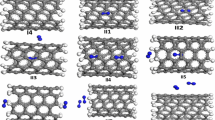Abstract
A theoretical approach based on a tight-binding model is developed to study the effects of the adsorption of finite concentrations of C6H5 gas molecules on double-walled carbon nanotube (DWCNT) electronic properties. To obtain proper hopping integrals and random on-site energies for the case of one molecule adsorption, the local density of states for various hopping integrals and random on-site energies are calculated. Since C6H5 molecule is a donor with respect to the carbon nanotubes and their states should appear near the conduction band of the system, effects of various hopping integral deviations and on-site energies for one molecule adsorption are considered to find proper hopping and on-site energies consistent with expected n-type semiconductor. We found that adsorption of C6H5 gas molecules could lead to a (8.0)@(20.0) DWCNT n-type semiconductor. The width of impurity adsorbed gas states in the density of states could be controlled by adsorbed gas concentration.
Similar content being viewed by others
References
S. Iijima, Nature 354, 56 (1991).
S. Iijima and T. Ichihashi, Nature 363, 603 (1993).
D. S. Bethune et al., Nature 363, 605 (1993).
J. P. Lu and J. Han, Int. J. High Electron. Syst. 9, 101 (1998).
P. G. Collins, K. Bradley, M. Ishigami, and Z. Zettl, Science 287, 1801 (2000).
J. Kong et al., Science 287, 622 (2000).
G. U. Sumanasekera, B. K. Pradhan, H. E. Romero, K.W. Adu, and P. C. Eklund, Phys. Rev. Lett. 89, 166801 (2002).
A. Star, T. R. Han, J. C. Gabriel, K. Bradley, and G. Grue- ner, Nano Lett. 3, 1421 (2003).
E. S. Snow, F. K. Perkine, E. J. Houser, S. C. Badescu, and T. L. Reinecke, Science 307, 1942 (2005).
H. Park, J. Zhao, and J. P. Lu, Nano Lett. 6, 916 (2006).
R. J. Chen, Y. Zhang, D. Wang, and H. J. Dai, J. Am. Chem. Soc. 123, 3838 (2001).
X. Wang, Y. Liu, W. Qiu, and D. Zhu, J. Mater. Chem. 12, 1636 (2002).
M. Penza, F. Antolini, and M. V. Antisari, Sensors Actuat. B 100, 47 (2004).
H. Gao and Y. Kong, Ann. Rev. Mater. Res. 34, 123 (2004).
S. Chopra, K. McGuire, N. Gothard, M. A. Rao, and A. Pham, Appl. Phys. Lett. 83, 2280 (2003).
M. J. Moghaddam, S. Taylor, M. Gao, S. Huang, L. Dai, and M. J. McCall, Nano Lett. 4, 89 (2004).
S. H. Jhi, S. G. Louie, and M. L. Cohen, Phys. Rev. Lett. 85, 1710 (2000).
R. Moradian, J. Phys.: Condens. Matter. 8, 507 (2006).
R. Moradian and A. Fathalian, Nanotechnology 17, 1835 (2006).
A. Fathalian, S. X. Dou, and R. Moradian, Physica B 405, 1125 (2010).
Author information
Authors and Affiliations
Corresponding author
Additional information
The article is published in the original.
Rights and permissions
About this article
Cite this article
Fathalian, A. The adsorption effect of C6H5 on density of states for double wall carbon nanotubes by tight binding model. Semiconductors 46, 769–772 (2012). https://doi.org/10.1134/S1063782612060103
Received:
Accepted:
Published:
Issue Date:
DOI: https://doi.org/10.1134/S1063782612060103




